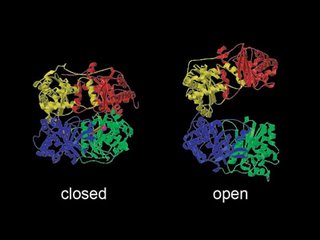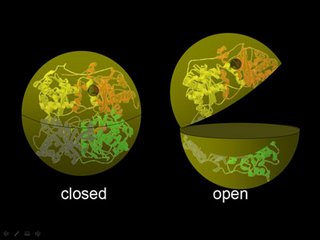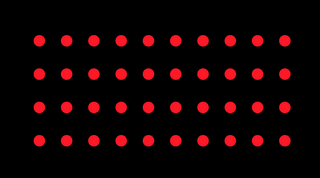Q: What does IDE look like?
A: Pac-Man…...on a diet
Last time, I reported on two very exciting developments regarding insulin-degrading enzyme (IDE), a protease that destroys beta-amyloid by chopping it into pieces. One of the most important advances was the unveiling of the 3-dimensional structure of IDE. This information is priceless, and useful for a large number of applications, particularly for understanding how the enzyme functions and also for designing drugs.
My job on this blog, together with Susan Shepard, is to convey these scientific advances in a way that non-scientists can understand. If you’re anything like me, then one of the easiest ways to understand new concepts is through pictures. Now that we have the 3-dimensional structure of IDE, I can show you pictures of this most important and exciting protease.
The structures show that IDE consists of two bowl-shaped halves connected by a flexible hinge. These new structures of human IDE, together with the structure of a bacterial relative of IDE, show that the protease can open and close, in a manner not unlike the main character in the familiar video game“Pac-Man." Take a look at this series of pictures to get a feel for what I mean by this:



Now, from these new structures, came a very significant discovery. It turns out that the two halves make extensive contacts with each other when the mouth is shut, and this tends to keep IDE in the closed state. I like to use the analogy of a “latch,” like the magnetic ones on some purses, for example, which is represented by the green bits in the following picture:

Normally, the latch is engaged, meaning the “closed” state predominates:

What does this mean for IDE function? It means that IDE is a bit different from the Pac-Man we all know and love. Because IDE’s mouth is usually closed, it can’t gobble up all the dots (e.g., beta-amyloid molecules) it encounters. To help get this message across, I collaborated with Adam (“AJ”) Brockman, a very talented young graphic designer. The following movie makes the point that IDE can’t normally gobble up all the dots because his mouth is usually closed: (click on image to view animation)

Now, as we discussed last time, the team that uncovered the structure of IDE, led by Wei-Jen Tang, showed how very important this “latch” is to IDE function, and to the potential development of new treatments for Alzheimer’s. They introduced small changes in IDE that disrupted this “latch” mechanism. To signify these changes, we have colored the latch red instead of green in the following picture:

By disrupting the latch, these small changes cause IDE to be more likely to adopt the “open” configuration, like so:

Hopefully you can guess the punchline: disrupting the latch allows IDE to gobble up more dots, just like the original Pac-Man. Here’s another movie of AJ’s that makes this point: (click on image to view animation)

These movies vividly make the point that disruption of IDE’s latch essentially puts a turbo boost on IDE. The above movies depict an increase of 333% (3 out of 10 dots are gobbled up in the first movie, versus 10 out of 10 in the second). In reality, the mutations Dr. Tang’s team made caused an increase of 4000%! To depict just how big of an effect this is, the first movie would have to show just a single dot getting gobbled up (1 out of a total of 40), with the second movie showing all the dots getting gobbled up (40 out of a total of 40).
What does all this have to do with Alzheimer’s disease? Well, the changes that Dr. Tang’s team made to IDE are relatively small, small enough that they should be able to be mimicked by drugs. That is, there is a strong prediction that small molecules can be found that also disrupt IDE’s latch, and also turn on the “turbo boost.” Indeed, my lab has already found some compounds that activate IDE by ~350%, essentially the same amount that the movies show. There’s a lot of work yet to do, and most likely much better compounds will eventually be discovered, but the idea that a drug can be found is a dramatic development, that should give us all a lot of hope.

Dr. Leissring: What a fantastic Blog for helping to understanding AD, which is a slowly progressive disease that eventually destroys not only the patient, but in most cases, their families too. Though not directly related to Elan, I understand you were formerly Dr. Selkoe's (Elan) lead researcher. While Elan is working on AAB-001 for AD, they also have Tysabri for MS patients (of which I am one). I just wanted to take this opportunity to thank you for all you have done for patients everywhere. Happy Holidays to you and yours, as well as to the family/creators of this Blog. Lauren Roberts
ReplyDeleteHi Malcolm, thanks for continuing to explain the research in this area. I love AJ's graphics...
ReplyDelete